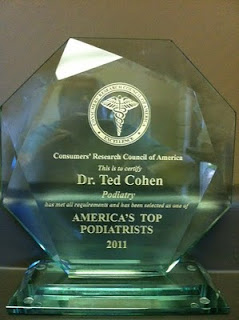
Wednesday, September 28, 2011
Tuesday, September 27, 2011
Monday, September 26, 2011
Thursday, September 22, 2011
Wednesday, September 21, 2011
Tuesday, September 20, 2011
Platelet Rich Plasma
Platelet Rich Plasma Therapy: The Next Big Thing in Podiatry
What is PRP and Why is it Helpful for Foot and Ankle Injuries?
Platelet Rich Plasma (PRP) Therapy is the up-and-coming treatment method for those with sport-related injuries in the foot and ankle. Many professional athletes are already regularly utilizing Platelet Rich Plasma Therapy to aid their muscle injuries or healing surgical wounds.
What is Platelet Rich Plasma Therapy and how does PRP work?
Platelet Rich Plasma is an essential ingredient to our body’s tissue engineering. Found in our blood stream, PRP is a concentrated source of autologous platelets, which are the cell-fragments that we use in order to stimulate bone and soft tissue healing.
Platelet Rich Plasma Therapy starts off with a small vial of blood taken from the patient. In order to isolate the PRP from the rest of the blood, the vile is placed in a centrifuge and is spun until the two substances separate. Once the spinning process is over, the PRP will be separate from the rest of the blood and can then be collected and injected directly to the site of injury.
Why Platelet Rich Plasma Therapy could be right for you:
The mere fact that admired professional athletes and celebrities use Platelet Rich Plasma Therapy might be enough to convince some people to try PRP Therapy for themselves. But there are many other reasons why someone with a foot or ankle injury should try out Platelet Rich Plasma (PRP) Therapy aside from its newfound high-status reputation.
PRP starts working quickly
From collecting the blood at the start of the process, to the time the PRP is injected, an entire session of Platelet Rich Plasma Therapy takes about one hour. During the 15 minutes that the centrifuge spins the patient will receive a topical anesthetic to ease the injury pain and to prepare the body for the PRP injection. The injection of the PRP takes about a half hour.
PRP has a high success rate
Platelet Rich Plasma Therapy has an improvement rate of about 85%. While the patient may experience some heightened pain for up to seven days after injection, Platelet Rich Plasma Therapy promotes long lasting healing and more permanent pain relief.
PRP is natural
Don’t be fooled by the fact that you will be sitting in a doctor’s office during your treatment session. Platelet Rich Plasma Therapy mimics the body’s natural response to soft tissue injuries, so the PRP that is being injected is what would ultimately end up at the point of injury regardless of the therapy. Platelet Rich Plasma Therapy just speeds up the process ten-fold.
While Platelet Rich Plasma Therapy does often have significant results after just one treatment, depending on the severity of the injury and your body’s response to the treatment you may need to go back for another treatment after about three weeks, and then possibly again after another six months.
What is PRP and Why is it Helpful for Foot and Ankle Injuries?
Platelet Rich Plasma (PRP) Therapy is the up-and-coming treatment method for those with sport-related injuries in the foot and ankle. Many professional athletes are already regularly utilizing Platelet Rich Plasma Therapy to aid their muscle injuries or healing surgical wounds.
What is Platelet Rich Plasma Therapy and how does PRP work?
Platelet Rich Plasma is an essential ingredient to our body’s tissue engineering. Found in our blood stream, PRP is a concentrated source of autologous platelets, which are the cell-fragments that we use in order to stimulate bone and soft tissue healing.
Platelet Rich Plasma Therapy starts off with a small vial of blood taken from the patient. In order to isolate the PRP from the rest of the blood, the vile is placed in a centrifuge and is spun until the two substances separate. Once the spinning process is over, the PRP will be separate from the rest of the blood and can then be collected and injected directly to the site of injury.
Why Platelet Rich Plasma Therapy could be right for you:
The mere fact that admired professional athletes and celebrities use Platelet Rich Plasma Therapy might be enough to convince some people to try PRP Therapy for themselves. But there are many other reasons why someone with a foot or ankle injury should try out Platelet Rich Plasma (PRP) Therapy aside from its newfound high-status reputation.
PRP starts working quickly
From collecting the blood at the start of the process, to the time the PRP is injected, an entire session of Platelet Rich Plasma Therapy takes about one hour. During the 15 minutes that the centrifuge spins the patient will receive a topical anesthetic to ease the injury pain and to prepare the body for the PRP injection. The injection of the PRP takes about a half hour.
PRP has a high success rate
Platelet Rich Plasma Therapy has an improvement rate of about 85%. While the patient may experience some heightened pain for up to seven days after injection, Platelet Rich Plasma Therapy promotes long lasting healing and more permanent pain relief.
PRP is natural
Don’t be fooled by the fact that you will be sitting in a doctor’s office during your treatment session. Platelet Rich Plasma Therapy mimics the body’s natural response to soft tissue injuries, so the PRP that is being injected is what would ultimately end up at the point of injury regardless of the therapy. Platelet Rich Plasma Therapy just speeds up the process ten-fold.
While Platelet Rich Plasma Therapy does often have significant results after just one treatment, depending on the severity of the injury and your body’s response to the treatment you may need to go back for another treatment after about three weeks, and then possibly again after another six months.
Thursday, September 8, 2011
Subscribe to:
Posts (Atom)





